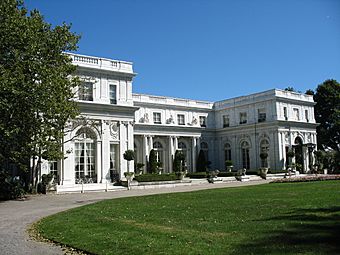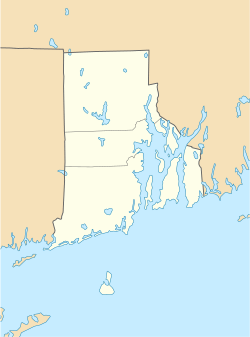Rosecliff facts for kids
|
Rosecliff
|
|
|
U.S. National Historic Landmark District
Contributing Property |
|
 |
|
| Location | 548 Bellevue Ave., Newport, Rhode Island |
|---|---|
| Area | 6.5 acres (2.6 ha) |
| Built | 1898-1902 |
| Architect | Stanford White McKim, Mead & White |
| Architectural style | French Baroque Revival |
| Part of | Bellevue Avenue Historic District (ID72000023) |
| NRHP reference No. | 73000059 |
Quick facts for kids Significant dates |
|
| Added to NRHP | February 6, 1973 |
| Designated NHLDCP | December 8, 1972 |
Rosecliff is a beautiful old mansion in Newport, Rhode Island. It was built during the Gilded Age, a time in American history (roughly 1870-1900) when many wealthy families built huge, fancy homes. Today, Rosecliff is open to the public as a historic house museum, meaning people can visit and learn about its past. It has also been known as the Hermann Oelrichs House or the J. Edgar Monroe House.
The mansion was built between 1898 and 1902 for Theresa Fair Oelrichs. She was a very rich heiress whose father, James G. Fair, made a fortune from the famous Comstock Lode silver mine in Nevada. Theresa and her husband, Hermann Oelrichs, bought the land in 1891. They hired a famous architecture firm called McKim, Mead, and White to design a grand summer home. Theresa loved to host big parties and quickly became one of Newport's most famous hostesses.
The main architect, Stanford White, designed Rosecliff to look like the Grand Trianon, a smaller palace at Versailles in France. Rosecliff is smaller than the Grand Trianon and shaped like an "H." It features arched windows and columns, similar to the French palace. White added a second floor with a hidden third floor above it, which contained many small rooms for the servants.
Contents
Building Rosecliff
The architectural firm of McKim, Mead, and White started building Rosecliff in 1898. Interior decorators from Jules Allard and Sons helped design the inside. Construction began in 1899, but a cold winter slowed things down. Even though the house wasn't fully finished, Mrs. Oelrichs moved in by July 1900. She even sent the workers out so she could host her first big party in August, a dinner for 112 guests! The house was finally completed in 1902.
Rosecliff is built of brick and covered with white terracotta tiles. Stanford White designed the rooms so that you could see through many doorways in a straight line, creating impressive views.
Inside the Mansion
The large central room of Rosecliff is the ballroom. It measures about 40 by 80 feet and was designed to be Newport's biggest ballroom. It has columns and arched windows, just like the outside of the house. French doors lead from the ballroom to a terrace that looks out over the ocean. There's also a garden terrace with a fountain.
In one of the wings of the house, you'll find the dining room and a billiard room. These rooms are separated by a marble hallway. Behind them, on the service side, is a butler's pantry with two dumbwaiters. These dumbwaiters connected to the kitchens, which were hidden below ground.
The main entrance is on the opposite wing. You enter through a vestibule, which leads to a grand Stair Hall. This hall has a large staircase that splits into two curving flights, leading up to the second floor.
Beyond the Stair Hall is the Salon, a large room that was originally decorated with tapestries. It has a beautiful ceiling and a unique Gothic-style fireplace made of Caen stone.
Upstairs, there are three large main bedrooms and several smaller guest bedrooms. These rooms could be connected or kept separate, offering flexible spaces for guests. All the bedrooms had their own bathrooms. There were also special dressing closets that separated the main rooms from the wide hallway, giving privacy from the staff. The staff used two small service staircases to move around the house.
One of Mrs. Oelrichs' most famous parties was the "Bal blanc" (White Ball) on August 19, 1904. Everything at this party was white and silver, and it was held to celebrate the Astor Cup Races. Mrs. Oelrichs passed away in Newport on November 22, 1926. Her funeral was held in the "beautiful blue and gold tapestry room" at Rosecliff.
The Monroe Family
Theresa Oelrichs' son, Hermann Oelrichs, Jr., kept Rosecliff in the family until 1941. After that, the estate had a few different owners before Mr. and Mrs. J. Edgar Monroe from New Orleans bought it in 1947. The Monroes came to Newport every summer to escape the heat of the South.
The Monroes became well-known for the large parties they hosted at Rosecliff. Many of their parties had a Mardi Gras theme, and the Monroes loved to dress up in fancy costumes. Unlike Mrs. Oelrichs' formal parties, the Monroes' parties were more relaxed and fun.
In 1941, Hermann Oelrichs Jr. sold all the furniture from the mansion. In 1971, Mr. and Mrs. Monroe generously donated the entire estate, along with its contents and money for its upkeep, to the Preservation Society of Newport County. The Society then opened Rosecliff to the public for tours. Mr. Monroe often returned to the estate for charity events until he passed away in 1991.
Interestingly, the American Beauty Rose flower was developed by an earlier owner of the property, George Bancroft, and his gardener.
Rosecliff in Movies and TV
Rosecliff's beautiful ballroom has been used as a filming location for several movies. These include the 1974 version of The Great Gatsby, The Betsy, High Society, True Lies, and Amistad.
In September 2017, the PBS television series Antiques Roadshow filmed three episodes inside and on the grounds of Rosecliff. About 3,000 people came to have their antique items valued. It was the first time in the show's 22 seasons that any appraisals were filmed outdoors. However, plans for all appraisals to be outside were changed due to rain from Hurricane Jose, so most appraisals took place inside the mansion or in tents. These three episodes first aired in May 2018.
See also
- Baroque Revival architecture
- List of Gilded Age mansions
- National Register of Historic Places listings in Newport County, Rhode Island



